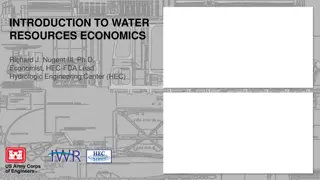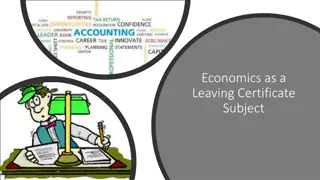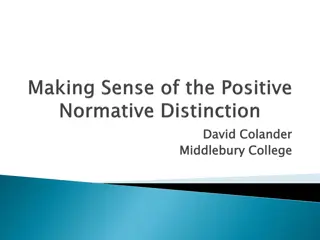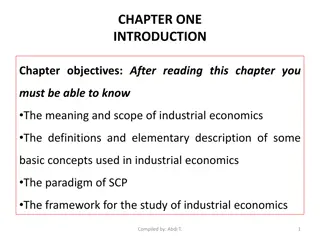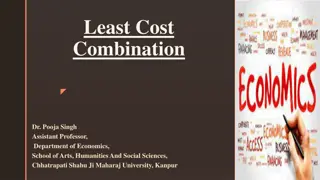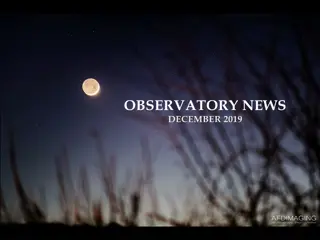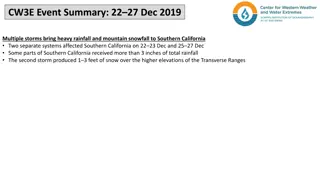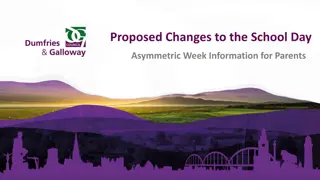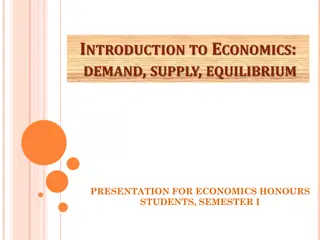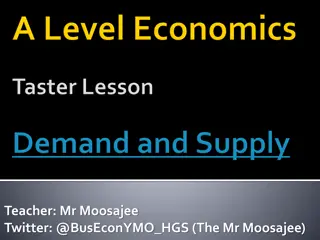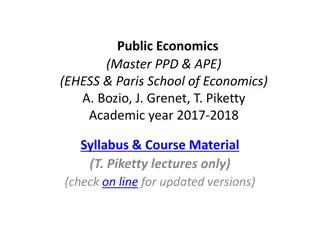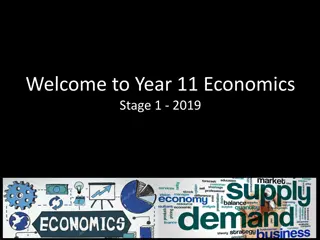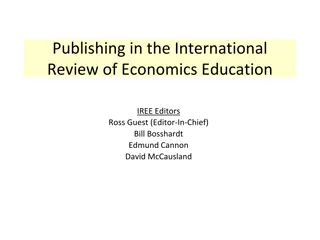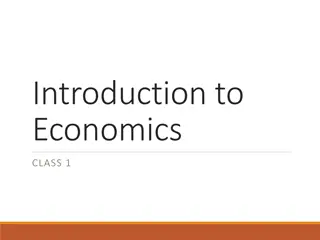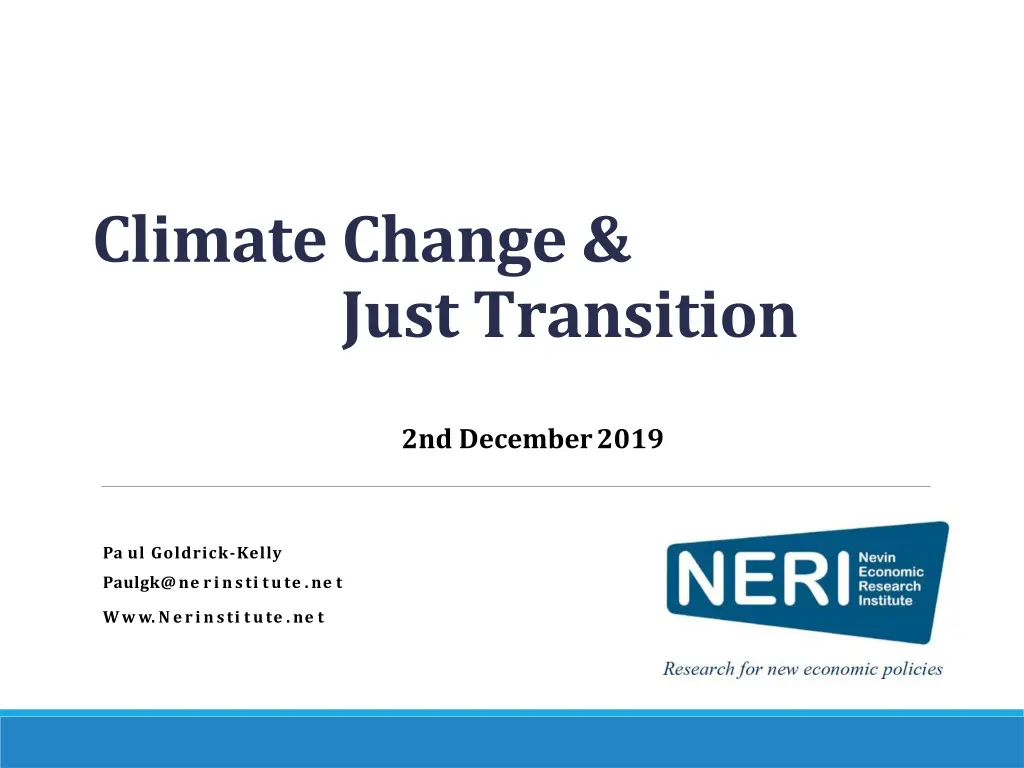
Just Transition and Climate Change Challenges
Discover the global challenge of human activity destabilizing natural systems, leading to mass extinctions and rising global temperatures. Explore the need for rapid transitions in energy, land use, and industrial systems to limit global warming to 1.5°C. Learn how economists conceptualize the problem of increasing emissions with economic growth.
Download Presentation

Please find below an Image/Link to download the presentation.
The content on the website is provided AS IS for your information and personal use only. It may not be sold, licensed, or shared on other websites without obtaining consent from the author. If you encounter any issues during the download, it is possible that the publisher has removed the file from their server.
You are allowed to download the files provided on this website for personal or commercial use, subject to the condition that they are used lawfully. All files are the property of their respective owners.
The content on the website is provided AS IS for your information and personal use only. It may not be sold, licensed, or shared on other websites without obtaining consent from the author.
E N D
Presentation Transcript
Climate Change & Just Transition 2nd December2019 Pa ul Goldrick-Kelly Paulgk@ne rinsti tute .ne t Www.Nerinsti tute .ne t
Part I: The Global Challenge
Introduction Globally, human activity is destabilising a number of natural systems. We re observing mass extinctions vertebrate populations reduced by 60% since the 70s, extinction rates c.100-1000 times higher than background rate (Laybourn-Langton, Rankin & Baxter, 2019). Other symptoms land degradation, ocean acidification, interruption of biochemical flows etc.
The idea of planetary boundaries
Climate Change Increased concentrations of greenhouse gases in the atmosphere are implicated in rising global temperatures. Average temperatures are 1.1 C above pre-industrial levels, atmospheric CO2 levels were last at similar levels about 3 million years ago (Lindsey, 2019). Emissions continue to rise, and reached record levels in 2018 (UN, 2019). Every year of postponed action implies deeper and faster cuts to achieve recommended pathways.
Emissions Trajectory (Hausfather, 2019)
Emissions Reductions Source: UN Emissions Gap Report 2019
What does this mean? Pathways limiting global warming to 1.5 C with no or limited overshoot would require rapid and far-reaching transitions in energy, land, urban and infrastructure (including transport and buildings), and industrial systems. These systems transitions are unprecedented in terms of scale, but not necessarily in terms of speed, and imply deep emissions reductions in all sectors, a wide portfolio of mitigation options and a significant upscaling of investments in those options. The rates of system changes [...] have occurred in the past within specific sectors, technologies and spatial contexts, but there is no documented historic precedent for their scale. IPCC, SR15 Summary for Policy Makers
How economists conceptualise the problem As output has increased, energy use and consequent emissions have gone in the same direction. Standard (Neoclassical) approaches see this as primarily a failure to incorporate the cost of carbon which represents a negative externality. You can solve this by introducing a Pigouvian Tax. incorrect prices. You could make a market to trade emissions rights or pollution allowances Coase Theorem missing markets/imperfect property rights.
How economists conceptualise the problem Ecologists and other economic schools tend to critique this perspective for a number of reasons: It fails to recognise persistent failures by markets to solve environmental problems. Proposed solutions don t account for impacts on different people. It tends to see the economy as dissembled from society and nature more broadly. Some see the pursuit of growth as a problem in and of itself. A focus on consumption fails to address the production process and the dynamics therein. The Just Transition approach can be seen as a response that incorporates some of these critiques.
Part II: What is a Just Transition ?
History of the concept Just Transition emerged in the labour movement in the 1970s (UNRISD,2018). Commonly credited to Tony Mazzocchi from the Oil, Chemical and Atomic Workers Union (OCAW). This involved an acknowledgement of the environmental damage associated with the industries they worked in. At the same time, Mazzocchi and his collaborators believed that it didn t mean that the communities reliant on these jobs should be sacrificed.
Just Transition Defined The concept of the Just Transition attempts to accommodate and address social concerns and possible inequities that may arise in a shift a sustainable economy. This means that environmental policy should not cause undue social or economic harm to workers and communities reliant on damaging activities. This is key for political feasibility asking workers to disproportionately shoulder the costs of a society wide transition will engender opposition.
Just Transition Criteria The ETUC (2015) identifies 5 key elements of a Just Transition: Participation engagement of all society including the workforce. Jobs access to decent work. Training and Education Respect for democratic rights rights to union organisation and human rights. Social Protection a social safety net to lessen the impacts of job losses.
International Experience The principle of a Just Transition is increasingly recognised internationally, it is included in the Paris Accords to which Ireland is a signatory. We have examples of what we d call structural transitions in other countries. A common feature in many international examples is local reliance on a dirty industry that is under threat for various reasons. In some cases, the transition occurred with new activity taking root. In others, things were left to the market ..
International Experience The existing examples of transition away from carbon intensive activities are the experience of coal reliant regions. The successful case often referred to is the Ruhr in Germany. Unsuccessful cases include the Appalachia region of the United States and South Wales. The broad approach taken in each is instructive.
The Ruhr The Ruhr is typically cited as a successful transition case: The federal and regional governments pursued active policy to diversify the region s economy away from coal. An emphasis on the availability of decent work supply and demand accounted for here. The region is now a leader in energy tech and consulting. Provision of extensive retraining and education courses with high placement rates. German social partnership incorporates a significant role for trade unions and worker representation. Collective agreements shape policy formation and implementation. Planning with staggered closures.
Appalachia On the other hand, Appalachia can be seen as a warning: The federal government rarely engaged in planning, funding or coordinated policy responses. Policy that did arise was essentially reactive and ad hoc. The emphasis of policy was to generally subsidise business to try and encourage inward investment. Infrastructure spending was not forthcoming. Little effort was made to augment worker skills to ensure they could take new jobs. Little commitment to the concept of green transition and collaborative decision making. General hostility to trade unionism.
Part III: What is the situation in Ireland?
Where we are (Goldrick- Kelly & Nugent, 2019) 25.0 20.0 15.0 10.0 5.0 0.0
Emissions Projections (EPA, 2019)
What does this mean? The EPAs emissions projections see Ireland miss its EU targets for 2020 and 2030 under both scenarios. We will overshoot our carbon budget by between 7-22 million tonnes CO2 equivalent. We will incur direct fines as a result from the European commission of up to 600 million annually. It isn t clear that these targets are consistent with the 1.5 degree scenario themselves!
Part IV: Just Transition in the Irish Context
Some Just Transition issues in Ireland Who is at risk? We have already seen that jobs in Peat are unsustainable who else might face significant job change? Is there a regional dimension to this? Are at risk jobs distributed evenly around the country? What other issues does this pose? What kinds of skills do we need for green jobs? What is the current skills profile here? What about the demand side?
Proportions of emissions and employment by Sector 2017 (Goldrick-Kelly & Nugent, 2019)
Regional dimension While data are limited, what is available suggests that more emissions intensive jobs are concentrated in places like the Border, Midlands and South West. In addition, while nationally, most new jobs generated in Ireland have been in low emissions sectors (c 85%), there is a significant disparity between regions. In the South-west and Midlands, less than 70% of new jobs were generated in low emitting sectors . This is particularly troubling in light of already observed disparities between regions.
Ratio of Gross Value Added per person in work Midlands to ROI average (ICTU,2019)
Regional issues Transition may be concentrated in regions that may already be trouble spots economically. This has some parallels to international experiences the Welsh valleys, Appalachia as mentioned. The danger is that the end of these industries doesn t see a rise in alternative high quality employment. In the absence of effective policy, these communities may be at high risk.
Skills for green jobs Any accounting of skills requirements requires knowledge of the nature of green jobs. This isn t as straightforward as you might think: There is no consensus on what are green jobs internationally. This is uncertain in light of changing technologies. Skills demand doesn t occur in a vacuum. Regardless, research suggests that skills demand will be biased towards things like STEM and Admin, Management and Business.
Skills Supply There is substantial variation in the skills profile of these sectors. Some sectors are better equipped for transition like Electricity , gas, steam and hot water (BnM, ESB) Some less so (Crop and animal production) Opportunities: Examining a broad measure of labour supply PLS4 (includes discouraged workers, those available but not seeking and part-time underemployed), we also observe unutilised skills in this population* Turning to selected regions, we identify a varied regional picture. Worryingly, Ireland displays low levels of in-job training, higher ed funding and a fraction of former apprenticeship levels.
Come back to international lessons International lessons include: Agreed Transition timelines through meaningful social dialogue. This allows for pro-active as opposed to reactive policy responses. Inclusion of local bodies in planning various levels of government, local actors. Labour market institutions for upskilling, eg. Swedish job security councils. Social security important elsewhere. Public investment for infrastructure and to support high skilled labour demand.
Broader questions Are current plans sufficient to both address emissions at the scale required in Ireland and ensure a Just Transition is pursued? Can this represent a development opportunity for Ireland? What might stop us? More broadly, how can we conceive of sustainable economies?
Climate Change & Just Transition 2nd December 2019 Pa ul Goldrick-Kelly Paulgk@ne rinsti tute .ne t Www.Nerinsti tute .ne t

